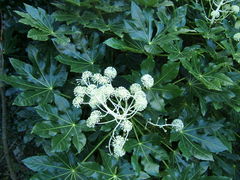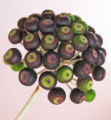Fatsia japonica: Difference between revisions
No edit summary |
No edit summary |
||
| Line 1: | Line 1: | ||
{{Inc| | |||
Fatsia japonica, Decne. & Planch. (Aralia japonica, Thunb., not Hort.? A. Sieboldii, Hort.). Lvs. downy at first, finally shining green: fls. in umbels. Japan, China.—Abroad are cult, forms with white or golden margins and a form reticulated with gold markings. Var. Moseri, Hort., is regarded as an improved, more compact-growing variety which originated with Moser of Fontainebleau. Intro, into Amer. by Mon- tarioso Nurseries, Santa Barbara, Calif. | |||
Wilhelm Miller. | |||
N. TAYLOB. | |||
}} | |||
{{Taxobox | {{Taxobox | ||
| color = lightgreen | | color = lightgreen | ||
Revision as of 14:01, 18 June 2009
| Standard Cyclopedia of Horticulture |
|---|
|
Fatsia japonica, Decne. & Planch. (Aralia japonica, Thunb., not Hort.? A. Sieboldii, Hort.). Lvs. downy at first, finally shining green: fls. in umbels. Japan, China.—Abroad are cult, forms with white or golden margins and a form reticulated with gold markings. Var. Moseri, Hort., is regarded as an improved, more compact-growing variety which originated with Moser of Fontainebleau. Intro, into Amer. by Mon- tarioso Nurseries, Santa Barbara, Calif. Wilhelm Miller. N. TAYLOB.
|
| Fatsia japonica {{{status}}} Fossil range: {{{fossil_range}}}
| ||||||||||||||||||||||||||||||||||||||||||||||||||||||||||||||||||
|---|---|---|---|---|---|---|---|---|---|---|---|---|---|---|---|---|---|---|---|---|---|---|---|---|---|---|---|---|---|---|---|---|---|---|---|---|---|---|---|---|---|---|---|---|---|---|---|---|---|---|---|---|---|---|---|---|---|---|---|---|---|---|---|---|---|---|
 | ||||||||||||||||||||||||||||||||||||||||||||||||||||||||||||||||||
| Plant Info | ||||||||||||||||||||||||||||||||||||||||||||||||||||||||||||||||||
| ||||||||||||||||||||||||||||||||||||||||||||||||||||||||||||||||||
| Scientific classification | ||||||||||||||||||||||||||||||||||||||||||||||||||||||||||||||||||
| ||||||||||||||||||||||||||||||||||||||||||||||||||||||||||||||||||
| [[{{{diversity_link}}}|Diversity]] | ||||||||||||||||||||||||||||||||||||||||||||||||||||||||||||||||||
| {{{diversity}}} | ||||||||||||||||||||||||||||||||||||||||||||||||||||||||||||||||||
| Binomial name | ||||||||||||||||||||||||||||||||||||||||||||||||||||||||||||||||||
| Fatsia japonica (Thunb.) Decne. & Planch. | ||||||||||||||||||||||||||||||||||||||||||||||||||||||||||||||||||
| Trinomial name | ||||||||||||||||||||||||||||||||||||||||||||||||||||||||||||||||||
| {{{trinomial}}} | ||||||||||||||||||||||||||||||||||||||||||||||||||||||||||||||||||
| Type Species | ||||||||||||||||||||||||||||||||||||||||||||||||||||||||||||||||||
| {{{type_species}}} | ||||||||||||||||||||||||||||||||||||||||||||||||||||||||||||||||||
| {{{subdivision_ranks}}} | ||||||||||||||||||||||||||||||||||||||||||||||||||||||||||||||||||
| [[Image:{{{range_map}}}|{{{range_map_width}}}|]] | ||||||||||||||||||||||||||||||||||||||||||||||||||||||||||||||||||
| Synonyms | ||||||||||||||||||||||||||||||||||||||||||||||||||||||||||||||||||
| {{{synonyms}}} |
Fatsia japonica (Fatsi or Japanese Aralia; syn. Aralia japonica Thunb., A. sieboldii Hort. ex K.Koch) is a species of Fatsia, native to southern Japan.
It is an evergreen shrub growing to 3-6 m tall, with stout, sparsely branched stems. The leaves are spirally-arranged, large, 20-50 cm in width and on a petiole up to 50 cm long, leathery, palmately lobed, with 7-9 broad lobes, divided to half or two-thirds of the way to the base of the leaf; the lobes are edged with coarse, blunt teeth. The flowers are small, white, borne in dense terminal compound umbels in late autumn or early winter, followed by small black fruit.
The name "Fatsi" is older Japanese, meaning 'eight' (in present-day Japanese hachi), referring to the eight lobes. The name "Japanese Aralia" is due to the genus formerly being classified within a broader interpretation of the related genus Aralia in the past.
Cultivation and uses
It is commonly grown as an ornamental plant in warm temperate regions where winters do not fall below about -15°C.
References
- Huxley, A., ed. (1992). New RHS Dictionary of Gardening. Macmillan.
- BBC Gardening: Fatsia japonica
-
Fruiting body
-
A small Fatsia japonica leaf
-
Close-up of flower umbel


